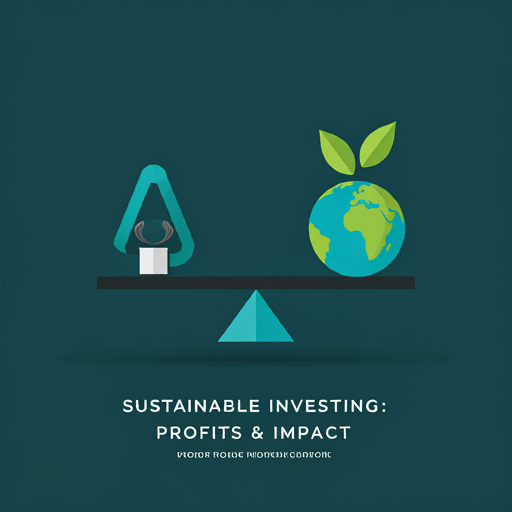Sustainable Investing: Balancing Profits and Environmental Impact
Definition and Importance
Sustainable investing refers to the practice of making investment decisions that consider both financial returns and positive environmental impact. This approach is increasingly important as investorx seek to align their portfolios with their values. It reflects a growing awareness of the interconnectedness of financial health and ecological sustainability. This is crucial for future generations. Investors are becoming more conscious of their choices.
Historical Context and Evolution
Sustainable investing has evolved significantly over the decades. Initially, it focused on socially responsible investing (SRI), which excluded certain industries. Key milestones include:
This evolution reflects changing investor priorities. Investors now seek both profit and purpose. This shift is noteworthy.
The Role of Cryptocurrency in Sustainable Investing
Overview of Cryptocurrency’s Environmental Impact
Cryptocurrency mining consumes significant energy, primarily due to the proof-of-work mechanism. This process requires vast computational power, leading to high carbon emissions. Many mining operations rely on fossil fuels, exacerbating environmental concerns. The impact is substantial and concerning.
In contrast, some cryptocurrencies are exploring eco-friendly alternatives. For instance, proof-of-stake models use less energy. This shift could mitigate environmental damage. It’s a promising development.
Potential for Positive Change in the Industry
The cryptocurrency industry has significant potential for positive change. By adopting sustainable practices, it can reduce its environmental footprint. Innovations like renewable energy-powered mining are emerging. This shift is essential for long-term viability.
Investors increasingly favor eco-conscious projects. This trend reflects a broader commitment to sustainability. It’s a critical opportunity for growth.
Key Principles of Sustainable Investing
Environmental, Social, and Governance (ESG) Criteria
Environmental, Social, and Governance (ESG) criteria are essential for sustainable investing. These criteria evaluate a company’s ethical impact and sustainability practices. Key components include:
These factors influence investment decisions. Investors seek transparency and accountability. This is crucial for informed choices.
Long-term Value Creation
Long-term value creation focuses on sustainable growth strategies. Companies that prioritize ESG factors often outperform their peers. This approach fosters resilience and adaptability in changing markets. Investors recognize the importance of sustainability.
Key strategies include:
These practices lead to sustainable profitability. This is a smart investment choice.
Challenges in Sustainable Cryptocurrency Investments
Energy Consumption and Carbon Footprint
Here are 10 trending article titles for a financial website based on the latest news and analysis of financial trends: No input data
Regulatory and Market Volatility
Regulatory uncertainty poses significant challenges for sustainable cryptocurrency investments. Frequent changes in legislation can disrupt market stability. This volatility creates risks for investors. He must navigate these complexities carefully.
Additionally, market fluctuations can impact investment returns. Price instability is a common concern. Investors should remain vigilant and informed. This is essential for success.
Innovative Solutions for Sustainable Practices
Green Mining Initiatives
Green mining initiatives focus on reducing the environmental impact of cryptocurrency mining. These initiatives often utilize renewable energy sources, such as solar and wind power. This approach significantly lowers carbon emissions. He can contribute to sustainability.
Key strategies include:
These practices enhance operational efficiency. This is a vital step forward.
Carbon Offsetting Strategies
Carbon offsetting strategies aim to neutralize emissions generated by cryptocurrency activities. These strategies often involve investing in projects that reduce greenhouse gases. Examples include reforestation and renewable energy initiatives. He can make a positive impact.
Key components include:
These actions contribute to environmental sustainability. This is a responsible choice.
Case Studies of Sustainable Cryptocurrencies
Successful Projects and Their Impact
Successful projects in sustainable cryptocurrencies demonstrate significant impact. For instance, projects utilizing renewable energy sources have reduced carbon footprints substantially. He can see measurable benefits.
Key examples include:
These projects enhance community engagement. This is a positive development.
Lessons Learned from Failures
Failures in sustainable cryptocurrency projects provide valuable insights. Many initiatives underestimated energy consumption and regulatory challenges. This oversight led to financial losses. He must learn from these mistakes.
Key lessons include:
These factors are crucial for success. This is a critical takeaway.
Future Trends in Sustainable Cryptocurrency Investing
Emerging Technologies and Their Potential
Emerging technologies are reshaping sustainable cryptocurrency investing. Innovations such as blockchain interoperability and decentralized finance (DeFi) are gaining traction. These advancements enhance efficiency and transparency. He can benefit from these trends.
Additionally, artificial intelligence is being integrated into investment strategies. This integration allows for better risk assessment and decision-making.
Shifts in Investor Behavior and Preferences
Shifts in investor behavior indicate a growing preference for sustainable assets. Many investors now prioritize environmental impact alongside financial returns. This trend reflects a broader societal commitment to sustainability. He is part of this change.
Key factors influencing this shift include:
These elements drive investment decisions. This is a significant transformation.
Conclusion: The Path Forward
Balancing Profitability and Responsibility
Balancing profitability and responsibility is essential for sustainable investing. Investors must consider both financial returns and ethical implications. This dual focus fosters long-term success. He can achieve this balance.
Key strategies include:
These actions promote responsible growth. This is a necessary approach.
Call to Action for Investors and Stakeholders
Investors and stakeholders must actively engage in sustainable practices. By prioritizing responsible investments, they can drive meaningful change. This commitment enhances both financial performance and societal impact. He should take action now.
Key steps include:
These efforts are crucial for progress. This is a shared responsibility.
